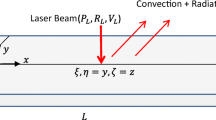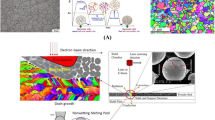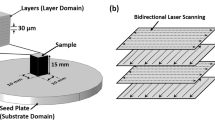Abstract
In the Air Force Research Laboratory Additive Manufacturing Challenge Series, melted track geometries for a laser powder bed fusion (L-PBF) process of Inconel 625 were used to challenge and validate computational models predicting melting and solidification behavior. The impact of process parameters upon single-track single-layer, multi-track single-layer, and single-track multi-layer L-PBF processes was studied. To accomplish this, a physics-based thermal-fluid model was developed and calibrated using a proper generalized decomposition surrogate model, then compared against the experimental measurements. The thermal-fluid model was enhanced through the usage of an adaptive mesh and residual heat factor (RHF) model, based on the scanning strategy, for improved efficiency and accuracy. It is found that this calibration approach is not only robust and efficient, but it also enables the thermal-fluid model to make predictions which quantitatively agree well with the experimental measurements. The adaptive mesh provides over a 10-times speedup as compared to a uniform mesh. The RHF model improves predictive accuracy by over 60%, particularly near starting and ending points of the melted tracks, which are greatly affected by the thermal behavior of adjacent tracks. Moreover, the thermal-fluid model is shown to potentially predict lack-of-fusion defects and provide insights into the defect generation process in L-PBF.

















Similar content being viewed by others
References
Bourell D, Beaman J, Marcus H, Barlow J (1990) Solid freeform fabrication: an advanced manufacturing approach. In: International solid freeform fabrication symposium, pp 1–7
Vojislav P, Juan VHG, Olga JF, Javier DG, Jose RBP, Luis PG (2011) Additive layered manufacturing: sectors of industrial application shown through case studies. Int J Prod Res 49:1061–1079
Yan C, Hussein A, Raymont D (2012) Evaluations of cellular lattice structures manufactured using selective laser melting. Int J Mach Tools Manuf 62:32–38
Guo N, Leu MC (2013) Additive manufacturing: technology, applications and research needs. Front Mech Eng 8:215–243
Bourell D, Leu M, Rosen D (2009) Roadmap for additive manufacturing-Identifying the future of freeform processing. The University of Texas at Austin, Laboratory for Freeform Fabrication, Advanced Manufacturing Center
Liu Y, Li S, Wang H, Hou W, Hao Y, Yang R, Sercombe T, Zhang L (2016) Microstructure, defects and mechanical behavior of beta-type titanium porous structures manufactured by electron beam melting and selective laser melting. Acta Mater 113:56–67
Witherell P, Feng SC, Martukanitz R, Simpson TW, John DB, Michaleris P, Liu Z-k, Chen L-q (2014) Toward metamodels for composable and reusable additive manufacturing process models. In: 34th computers and information in engineering conference, proceedings of the ASME design engineering technical conference, American Society of Mechanical Engineers (ASME), p 061025
Cunningham R, Narra SP, Montgomery C, Beuth J, Rollett AD (2017) Synchrotron-based x-ray microtomography characterization of the effect of processing variables on porosity formation in laser power-bed additive manufacturing of Ti-6Al-4V. JOM 69:479–484
Tang M, Postorius PC, Beuth JL (2017) Prediction of lack-of-fusion porosity for powder bed fusion. Addit Manuf 14:39–48
Smith J, **ong W, Yan W, Lin S, Cheng P, Kafka OL, Wagner GJ, Cao J, Liu WK (2016) Linking process, structure, property, and performance for metal-based additive manufacturing: computational approaches with experimental support. Comput Mech 57:583–610
Gan Z, Liu H, Li S, He X, Yu G (2017) Modeling of thermal behavior and mass transport in multi-layer laser additive manufacturing of Ni-based alloy on cast iron. Int J Heat Mass Transf 111:709–722
Ghosh S, Ma L, Levine LE, Ricker RE, Stoudt MR, Heigel JC, Guyer JE (2018) Single-track melt-pool measurements and microstructures in inconel 625. JOM 70:1–6
Yan W, Lu Y, Jones K, Yang Z, Fox J, Witherell P, Wagner G, Liu WK (2020) Data-driven characterization of thermal models for powder-bed-fusion additive manufacturing. Addit Manuf 36:101503
Gan Z, Lian Y, Lin SE, Jones KK, Liu WK, Wagner GJ (2019) Benchmark study of thermal behavior, surface topography, and dendritic microstructure in selective laser melting of inconel 625. Integr Mater Manuf Innov 8:178–193
Heigel JC, Lane BM (2018) Measurement of the melt pool length during single scan tracks in a commercial laser powder bed fusion process. J Manuf Sci Eng 140:051012
Zhao C, Fezzaa K, Cunningham RW, Wen H, De Carlo F, Chen L, Rollett AD, Sun T (2017) Real-time monitoring of laser powder bed fusion process using high-speed x-ray imaging and diffraction. Sci Rep 7:3602
Fox JC, Lane BM, Yeung H (2017) Measurement of process dynamics through coaxially aligned high speed near-infrared imaging in laser powder bed fusion additive manufacturing. In: Bison P, Burleigh D (Eds.), Thermosense: thermal infrared applications XXXIX, volume 10214, International Society for Optics and Photonics, SPIE, pp 34–50. https://doi.org/10.1117/12.2263863
Lane B, Heigel J, Ricker R, Zhirnov I, Khromschenko V, Weaver J, Phan T, Stoudt M, Mekhontsev S, Levine L (2020) Measurements of melt pool geometry and cooling rates of individual laser traces on in625 bare plates. Integr Mater Manuf Innov 9:16–30
Heigel JC, Lane BM, Levine LE (2020) In situ measurements of melt-pool length and cooling rate during 3d builds of the metal AM-bench artifacts. Integr Mater Manuf Innov 9:31–53
America Makes (2019a) America makes and air force research laboratory announce an additive manufacturing modeling challenge series. https://www.americamakes.us/america-makes-and-afrl-announce-am-modeling-challenge/
America Makes (2019b) Air force research laboratory (AFRL) additive manufacturing modeling challenge series. https://www.americamakes.us/am-modeling-challenge-series/
Edwin MAG, Schwalbach J, Chapman Michael G (2021) AFRL additive manufacturing modeling series: challenge 2—microscale process to structure data description. In review
Lu Y, Blal N, Gravouil A (2018) Adaptive sparse grid based HOPGD: toward a nonintrusive strategy for constructing space-time welding computational vademecum. Int J Numer Methods Eng 114:1438–1461
Lu Y, Blal N, Gravouil A (2019) Datadriven HOPGD based computational vademecum for welding parameter identification. Comput Mech 64:47–62
Gan Z, Yu G, He X, Li S (2017) Numerical simulation of thermal behavior and multicomponent mass transfer in direct laser deposition of co-base alloy on steel. Int J Heat Mass Transf 104:28–38
Lian Y, Gan Z, Yu C, Kats D, Liu WK, Wagner GJ (2019) A cellular automaton finite volume method for microstructure evolution during additive manufacturing. Mater Des 169:107672
Ye J, Khairallah SA, Rubenchik AM, Crumb MF, Guss G, Belak J, Matthews MJ (2019) Energy coupling mechanisms and scaling behavior associated with laser powder bed fusion additive manufacturing. Adv Eng Mater 21:1900185
Fabbro R, Dal M, Peyre P, Coste F, Schneider M, Gunenthiram V (2018) Analysis and possible estimation of keyhole depths evolution, using laser operating parameters and material properties. J Laser Appl 30:032410
Capriccioli A, Frosi P (2009) Multipurpose ansys fe procedure for welding processes simulation. In: Fusion engineering and design 84 546–553. Proceeding of the 25th symposium on fusion technology
America Makes (2019) Air force research laboratory (AFRL) additive manufacturing modeling challenge series 2. https://materials-data-facility.github.io/MID3AS-AM-Challenge/Challenge2ProblemStatement_2019Release.pdf
Pawel R, Williams R (1985) Survey of physical property data for several alloys. Technical Report, Oak Ridge National Laboratory
Valencia JJ, Quested PN (2013) Thermophysical properties
Yeung H, Lane B (2020) A residual heat compensation based scan strategy for powder bed fusion additive manufacturing. Manuf Lett 25:56–59
Whitley D (1994) A genetic algorithm tutorial. Stat Comput 4:65–85
Lu Y, Blal N, Gravouil A (2018) Multi-parametric space-time computational vademecum for parametric studies: application to real time welding simulations. Finite Elements Anal Des 139:62–72
Lu Y, Blal N, Gravouil A (2018) Space-time pod based computational vademecums for parametric studies: application to thermo-mechanical problems. Adv Model Simul Eng Sci 5:1–27
Ammar A, Mokdad B, Chinesta F, Keunings R (2006) A new family of solvers for some classes of multidimensional partial differential equations encountered in kinetic theory modeling of complex fluids. J Nonnewton Fluid Mech 139:153–176
Néron D, Ladevèze P (2010) Proper generalized decomposition for multiscale and multiphysics problems. Arch Comput Methods Eng 17:351–372
Modesto D, Zlotnik S, Huerta A (2015) Proper generalized decomposition for parameterized helmholtz problems in heterogeneous and unbounded domains: Application to harbor agitation. Comput Methods Appl Mech Eng 295:127–149
Ghnatios C, Masson F, Huerta A, Leygue A, Cueto E, Chinesta F (2012) Proper generalized decomposition based dynamic data-driven control of thermal processes. Comput Methods Appl Mech Eng 213:29–41
Saha S, Kafka OL, Lu Y, Yu C, Liu WK (2021) Microscale structure to property prediction for additively manufactured in625 through advanced material model parameter identification. Integr Mater Manuf Innov. https://doi.org/10.1007/s40192-021-00208-5
Mukherjee T, Wei H, De A, DebRoy T (2018) Heat and fluid flow in additive manufacturing–part i: modeling of powder bed fusion. Comput Mater Sci 150:304–313
Martin AA, Calta NP, Khairallah SA, Wang J, Depond PJ, Fong AY, Thampy V, Guss GM, Kiss AM, Stone KH et al (2019) Dynamics of pore formation during laser powder bed fusion additive manufacturing. Nat Commun 10:1–10
Coeck S, Bisht M, Plas J, Verbist F (2019) Prediction of lack of fusion porosity in selective laser melting based on melt pool monitoring data. Addit Manuf 25:347–356
Yakout M, Elbestawi M, Veldhuis SC (2018) A study of thermal expansion coefficients and microstructure during selective laser melting of Invar 36 and stainless steel 316L. Addit Manuf 24:405–418
Acknowledgements
W. K. Liu acknowledges the support by the Center for Hierarchical Materials Design (CHiMaD) under Grant No. 70NANB14H012 and NSF Grant CMMI-1934367. Z. Gan and Y. Lu acknowledge the partial support of NSF Grants CMMI-1934367 and 1762035. K. Jones acknowledges the support by the Murphy Fellowship from Northwestern University and NSF Grant CMMI-1934367. We extend our appreciation to Dr. Edwin Schwalbach, Marie Cox, and the AM Challenge Series committee for their work and leadership in providing this valuable forum for the AM research community.
Author information
Authors and Affiliations
Corresponding authors
Ethics declarations
Conflict of interest
On behalf of all authors, the corresponding author states that there is no conflict of interest
Supplementary Information
Below is the link to the electronic supplementary material.
Rights and permissions
About this article
Cite this article
Gan, Z., Jones, K.K., Lu, Y. et al. Benchmark Study of Melted Track Geometries in Laser Powder Bed Fusion of Inconel 625. Integr Mater Manuf Innov 10, 177–195 (2021). https://doi.org/10.1007/s40192-021-00209-4
Received:
Accepted:
Published:
Issue Date:
DOI: https://doi.org/10.1007/s40192-021-00209-4




